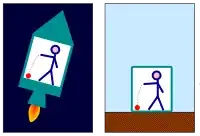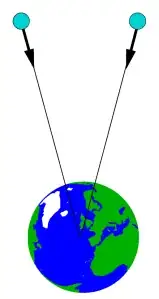After carefully considering the OP's situation, I believe the focus falls on the rhetorical process. Following from this, my argumentative approach would be the following: stand firm about the fact that Earth is round, get the child to reconcile the inconsistencies.
The reason for this kind of approach is the child's behavior. The following quote is a script that I have repeated over and over in physics tutoring:
I also made some attempts using a globe, saying that "Up" and "Down" are all local perspective and people on the other side of the earth feel they're on the top, but she still doesn't get it.
Here, you presented an argument. But what followed after that argument? There's no apparent commentary on the argument by the child. I have no expectation that a kid would retort with consistent or event coherent counter-arguments, but the response seems to be missing altogether.
This is familiar to those of us with physics teaching experience. Wrong answers are always easy to deal with, and almost universally constructive. It's the lack of any model formation that blockades progress, and often leads them to switch majors to something non-technical because of the bad experience.
Consider the rhetoric to be like a chess game (with formally established rules for movement). As an educated adult, you probably don't have trouble responding to any move the child makes. If you do, ask another question here.
No rhetorical approach will be helpful 100% of the time. Counter-examples aren't always helpful either, but they appeal to a very particular example of inconsistent logic. If you ascribed to the bad logic before you see the counter-example, then it will accomplish it's purpose - demonstrating that you're wrong. I think the best response I've seen here was the following image (posted as a comment):

(image originally from http://www.caloi.com.ar/caloidoscopio_new/byn/byn53.gif)
This is physics perfection.
The absurd illustration makes the viewer abandon a view. You could reject that Earth is a sphere, or you could reject that gravity is always in the same direction. I suppose the option remains that people are presently, at this moment, falling off the side of the planet. I think that's what makes physics fun. For each model we build, there is a story that goes along with it. Most individual propositions can have a model built around it, changing everything else in the universe to accommodate. But once you are forced to explain multiple facts simultaneously, then you are in the process of building physics. Each model is a story. If you can start enjoying the process of telling those models/stories, then you are on your way to grad school.
I say physics involves two things: rationalism and evidence. Your model's consistency is dictated by reason, but which model applies is determined by evidence we get by the world around us (for which there is no mental shortcut). Here are some stories that do have consistency:
- Earth is flat, gravity is always down. The validity can more-or-less only be determined by measuring the Earth's shape.
- Earth is round, gravity is always the same direction. A privileged "top of the Earth" location exists, and everything else slopes down. You could verify this by observing a ball to roll off the edge of the world.
Maybe the best thing to do isn't to be correct, but show how you, yourself, enjoy being wrong. If they emulate that behavior, they will be fantastic scientists.




